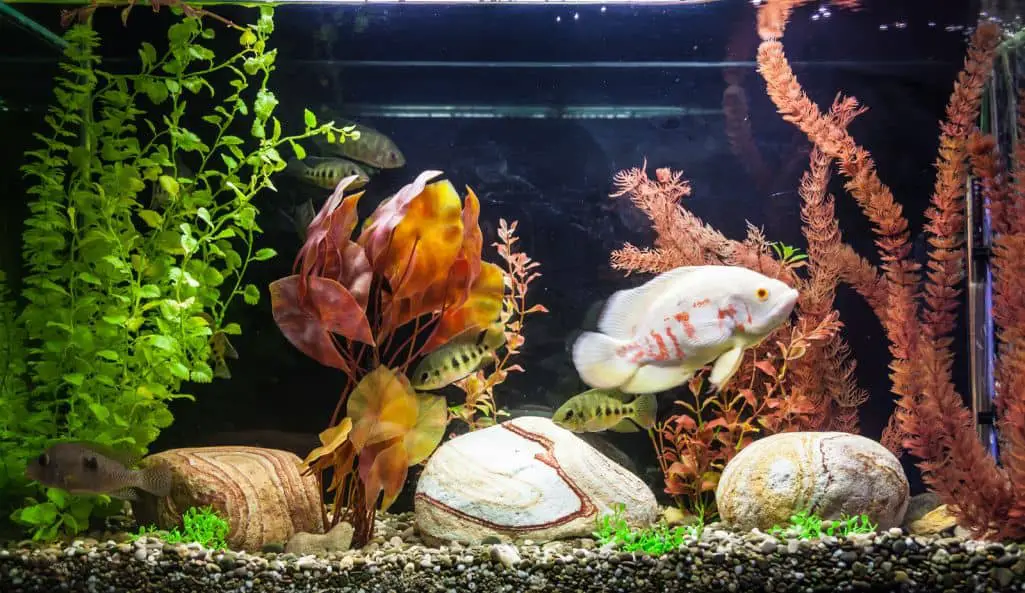6 Best Aquarium Vacuum Cleaner for Gravel & Sand (2023 Reviews)
After investing so much time, effort, and money into building the perfect aquarium, wouldn’t it be a total shame if you let it all go down the drain?
Unfortunately, this scenario is very likely to happen if you don’t regularly clean your aquarium.
We’re not just talking about a water change here, but rather a proper cleaning job starting from the tank’s bed.
Many people overlook cleaning gravel or sand, thinking water is the only thing that matters, when actually, dirty gravel may be the reason your aquarium’s water clouds up so often in the first place!
That’s why you need the best aquarium vacuum cleaner to keep your tank fresh and your fish healthy. However, with so many models and features available, the choice can be quite confusing.
Today, thanks to our detailed buying guide as well as the carefully reviewed list of the 6 best aquarium vacuum cleaners, we’ll be helping you land the perfect deal.
So let’s not waste any time and dive right in!
[amazon table=”7845″]
Table of Contents
Python No Spill Clean and Fill Aquarium Maintenance System
[amazon box=”B000255NXC”]
Kicking off our list with the No Spill Clean and Fill Aquarium Maintenance System from Python, this vacuum cleaner proudly sports thousands of soaring reviews, and for good reasons at that.
The Amazon bestseller is made in the USA using materials of premium quality to guarantee a dependable performance. You can use it to both clean and refill your tank’s water, meaning it’s a 2-in-1 tool.
The Python No Spill Clean and Fill is a convenient ready-to-use system that’ll require you to do some limited assembly. The package includes a hose, 10-inch gravel tube, hose connections, faucet pump, brass faucet adapter, and a switch.
This aquarium vacuum cleaner widely adapts to all sorts of faucets and is available in multiple hose lengths of 25, 50, 75, and 100 inches to accommodate various tank settings.
If cleaning your gravel calls for extra reach than the default 10-inch gravel tube, you can easily purchase an extension with an additional 20, 24, 30, 36, 48, or 72 inches.
Python’s No Spill Clean and Fill works quietly without disturbing your fish while eliminating the conventional use of siphons and carrying buckets. It’s a mess-free solution for both changing water and cleaning gravel.
- Reliable performance
- Widely adaptable to most faucets
- Multiple length options
- 2-in-1 operation
- Expensive
- Requires some practice to master
Check Price and Reviews on Amazon
Video: “No Spill Clean and Fill Water Change System by Python | Big Al’s”
Genuine TERA PUMP Aquarium Fish Tank Gravel Sand Cleaner
[amazon box=”B011DDJZ9Y”]
Next up we have another highly praised aquarium vacuum cleaner with thousands of satisfied customers swearing by its quality, the TERA PUMP Aquarium Cleaner.
This Fish Tank Gravel and Sand Cleaner comes in two models: the TRFTCLN-S and the TRFTCLN. The “S” version is smaller in size with a narrower suction tube. It offers an intake diameter of 0.7 inches, delivering 1 GPM (gallon per minute) of water volume.
It packs many handy features such as a water flow control option when you pinch the flow control tube, a filter to keep out large gravel from blocking the pump, as well as a suction cup that tightly sticks the tube to the tank’s glass. If you have small fish, the TRFTCLN is the right option.
The TRFTCLN is the bigger model, comes with an intake diameter of 1.7 inches and a water delivery volume of 1.5 GPM. It offers the same features, along with two types of nozzles.
A shorter nozzle that you can use to drain dirty water as well as a longer nozzle for removing leftover food and fish droppings. This version of the cleaner is best suited for large fish aquariums.
Both models of the TERA PUMP Aquarium Cleaner are made in Korea using BPA-free Polyethylene, EVA, and PVC. The TERA PUMP is a wonderful choice if you’re on the hunt for a budget-friendly yet efficient solution to your tank cleaning problems.
- Easy to use
- Cleans gravel while replacing water
- Patented unique pump filter
- Affordable
- Made of BPA-free plastic
- Lots of counterfeited models
- The hose can be longer
Check Price and Reviews on Amazon
Video: “TERA PUMP – Fish Tank Gravel Sand Siphon”
EHEIM Quick Vac Pro Automatic Gravel Cleaner and Sludge Extractor
[amazon box=”B003C5U2SU”]
The EHEIM Quick Vac Pro Automatic Gravel Cleaner is a good alternative if you want to ditch the manual vacuum approach. It’s very simple to use since there are no hoses or buckets involved.
Once you place the Quick Vac Pro inside your aquarium and switch it on, the adequate suction power will pick up dirt particles and extract sludge as well as water.
Then, the built-in mesh cartridge will trap even the tiniest debris, letting water back into the tank. After you’re done, snap out the mesh part to clean off the waste, then put it back for the following use.
The EHEIM Automatic Cleaner is operated by 4 AA batteries, which are included in the package, and runs for up to 4 hours each battery change. This makes it quite safe to use as there are no power cables to connect.
It’s suitable for nearly all aquarium sizes, as long as they have 12 inches of depth at minimum. The Quick Vac Pro isn’t recommended for fine gravel or sand, and it doesn’t offer water changing option.
When fully assembled, this electric aquarium vacuum stands at 24 inches tall. Also, it comes with a 2-year warranty from EHEIM.
- Battery-powered
- Decent suction power
- Easily removable mesh cartridge
- Batteries included
- 2-year EHEIM coverage
- Not for fine gravel
- Doesn’t drain water
Check Price and Reviews on Amazon
Video: “Introduction to the Quick Vac Pro from EHEIM”
Aqueon Siphon Vacuum Aquarium Gravel Cleaner
[amazon box=”B004RK40OQ”]
Designed to provide your aquarium with optimum maintenance, the Aqueon Siphon Vacuum Aquarium Gravel Cleaner delivers a straightforward use at a price you’d barely feel!
The mechanism of starting this tank vacuum is a definite no brainer, you just need to move the intake tube in a simple up and down motion. This will quickly trigger the self-priming feature so that water begins to flow into the siphon. The dirty water is then disposed of and the gravel falls back to the aquarium bed.
The Aqueon Aquarium Vacuum Cleaner is a handy tool, particularly if you’re looking for an easy way to perform quick water changes. It does an excellent job sucking up waste particles and debris from gravel, maintaining the sensitive balance inside your tank. It may be too powerful though, requiring you to isolate your fish before use.
A neat aspect of the Aqueon Vacuum is the fact that it’s available in 5 different sizes. The Mini 5″ tube is recommended for 1 to 5-gallon tanks, the Extender 9.5″ to 18″ is meant for 5 to 15-gallon aquariums, while the Medium 5″ works for tank’s size 5 to 20 gallons and the Medium 9″ is ideal if your aquarium is 15 to 35 gallons large.
However, if you own a huge tank of more than 40-gallon size, you should go with the Large 16″ model. The Aqueon Siphon is also equipped with a clip that securely attaches the drain hose to the inner side of the bucket.
- Very budget-friendly
- High suction power
- Built-in clip
- Suits various tank sizes
- You may need to remove fish before use
- The pumping technique may be tricky at first
Check Price and Reviews on Amazon
Video: “Aqueon | Siphon Vacuum Gravel Cleaners: Use”
Zacro Fish Tank Gravel Cleaner
[amazon box=”B079CGNGTC”]
If you’re searching for an all-inclusive aquarium cleaning kit that has everything you need to keep your tank fresh and your pets happy, then you should undoubtedly consider the Zacro Fish Tank Gravel Cleaner.
It’s made from rigid BPA-free plastic which is durable yet lightweight, completely safe to use in freshwater, saltwater, as well as around fish and plants. The Zacro Fish Tank Gravel Cleaner Kit includes a Rhinox tube, priming bulb, discharge hose, and faucet to controll the waterflow.
To operate the Zacro Fish Tank Gravel Cleaner, you’ll have to squeeze the hand pump rather vigorously for several times till you see water starting to flow up the tube. This may be a bit frustrating to learn initially, but you should get the hang of it in no time.
- Cheap price
- A manual pump to let you control suction power
- Comes with a faucet to controll the waterflow
- Easy to install
- Requires several pumps to start
- The tube material is a bit too flimsy
Check Price and Reviews on Amazon
Aqueon Aquarium Water Changer
[amazon box=”B000YAJKL6″]
Last but certainly not least, the Aqueon Aquarium Water Changer is specifically designed to save you the pain of using drainage buckets and enduring the horror of messy spills.
It gives you complete control over the water flow via a designated built-in on/off valve, helping you achieve the perfect amount of water flow which will dislodge the gravel to remove dirt and debris.
The Aqueon Aquarium Water Changer includes an 11-inch long gravel tube (where the water flow valve is located), a multi-connection faucet adaptor, and a water flow sink attachment with an anti-splash guard.
To start vacuuming, you need to attach the water flow assembly onto your sink’s faucet using the included faucet adaptor. At the same time, have the gravel tube submerged in tank water, then open the valve on the water flow assembly and close the one on the gravel tube.
Once you turn on the faucet, open the gravel tube valve and watch it take up water. If you want to switch to filling mode, just close the water assembly valve again and keep the one on the gravel tube open.
The Aqueon Aquarium Water Changer offers flexible tubing at a length of 25 feet or 50 feet.
- Good value for the price
- Lets you control water flow
- Equipped with splash-reducing guard
- Speedy performance
- Instructions may be too confusing
- Not very durable
Check Price and Reviews on Amazon
Video: “How To Use the Aqueon Aquarium Water Changer”
What is an Aquarium Vacuum Cleaner?
An aquarium vacuum cleaner is a handy tool designed specifically to help fish owners maintain a healthy environment for their swimming pets by cleaning sand, gravel, or other substrates decorating the bed of the tank.
Basically, an aquarium gravel cleaner consists of a plastic tube or pipe, typically with a diameter of 2 inches, connected to a hose on one end. There are 2 major ways by which this device usually works.
The first is when you put the tube inside the fish tank and use it to siphon dirty water out of your aquarium to replace it with fresh water, while also directing the tube to remove unwanted debris and clean your gravel at the same time.
The second mechanism of aquarium vacuum cleaners doesn’t involve taking water out of the tank, it’s a simple concept where water is sucked to pass over a mesh barrier that traps leftover food and organic waste. You can use this type in between water changes.
Why do You Need an Aquarium Vacuum Cleaner?
If you’ve taken up fishkeeping, then you should already know this activity comes with the responsibility of periodic cleaning to protect the well-being of your fish. An aquarium cleaner can seriously help you perform such a task easier, faster, and more efficiently.
There are 3 main benefits you can get out of an aquarium gravel cleaner:
Removing Debris
If we take a closer look at a tank’s bed, we’ll find a lot of waste particles stuck in the substrate gaps, building up to form a thick sludge of dirt. This unwanted debris could be uneaten food, fish poop, dead plants, or other toxic materials that you can’t possibly leave inside the tank to contaminate your fish surroundings.
Removing such stubborn pollutants is facilitated by the aid of aquarium vacuum cleaners, costing less effort and prolonging the time one water change and the next.
Keeping Water Chemistry in Check
The presence of contaminants, such as organic waste, for long periods in your fish tank, is bound to disturb the PH of the water in your aquarium. Fish and other marine life residing in the tank require certain levels of PH to stay healthy and thrive.
When you use an aquarium gravel cleaner to get rid of this debris, you also help maintain water chemistry balance for your fish.
Changing Water Easily
As we previously mentioned, one of the ways an aquarium vacuum cleaner works is by siphoning water out of the tank. This means it can save you the trouble of figuring out how to drain all the dirty water without making a mess, in less time and using little effort compared to conventional methods.
What are the Types of Aquarium Vacuum Cleaners?

Essentially, there are 2 types of aquarium vacuum cleaners available: manual cleaner and electric aquarium vacuum.
Manual Aquarium Vacuum
The simpler type out of the two, a manual vacuum cleaner is generally affordable and easy to handle with hassle-free operation once you master its technique.
This type utilizes a plastic tube with a top opening that attaches to a drainage hose. When you place the tube in your tank, water travels through it and down the hose to be drained.
Of course, you should be having a large container where you put the other end of the hose to collect the dirty water. This is crucial if you want to avoid getting drenched.
Also, be sure to locate this container at a lower position in relation to the tank since the whole manual siphon concept is based on gravity pull. To speed up the process, always keep the drainage hose in a straight pose.
Electric Aquarium Vacuum
If you don’t feel like dealing with all the siphons, hoses, and drainage containers, you may want to consider investing in an electric aquarium vacuum.
To operate this device, you just need to line up its components in a vertical position, then you flick a switch to get it running, and you’re all set! The electric aquarium vacuum will start sucking and cleaning while you sit back and wait.
However, there’s a catch or a few at that. First of all, such systems are more expensive than manual ones, so you’ll need to pay up extra cash. Secondly, if part of the vacuum malfunctions, replacements may be a bit difficult to find.
Moreover, most electric aquarium vacuum models produce noise while cleaning that may disturb you and your fish.
What to Consider Before Buying an Aquarium Vacuum Cleaner?
When shopping for the best aquarium vacuum cleaner, there are a number of factors you should consider first before making a final choice. Here are the most important ones:
Tank Size
Right off the bat, you should be checking how well your tank and aquarium cleaner fit together. This is done by carefully measuring the size of your tank and the quantity of water it holds in gallons, then comparing these values with the aquarium vacuum cleaner to make sure they’re compatible.
You don’t want an aquarium gravel cleaner working with too much power that it fails to provide a thorough cleansing or too little that it loses its purpose.
Depth
Another factor that seems to escape the radar of aquarium owners is the depth of their tanks. If you don’t want to end up with your entire arm dipped in dirty water, then you should determine the exact depth of your fish tank in order to match it with a proper tube length.
Aquarium Residents
Well, you can’t really use an aquarium vacuum cleaner without taking into account the inhabitants of the tank. Since fish and marine plants come in various types and sizes, you must keep in mind that the tube diameter is narrow enough to avoid accidents where fish gets stuck in the cleaner.
The last thing you want to do is risk the lives of your aquatic pets.
Operation Mechanism
This is where your preference matters the most. Aquarium gravel cleaners come in several suction mechanisms, some work by gravity, some utilize pumps, and some are electric. You should pick the type best suited for your needs and budget.
Substrate Size
If you’re searching for the best aquarium vacuum cleaner, your decision should be according to how big or small the substrate covering your tank’s bed is. The substrate size dictates the diameter of the tube opening.
For large gravel in 20-gallon or bigger aquariums, the standard size of the 2-inch opening should be acceptable. The smaller the substrate is, the tinier the opening should be.
Warranty
Finally, you should pay just as much attention to the warranty policies offered by manufacturers of aquarium vacuum cleaners. Different brands will back up their products with various warranty periods under terms that include full refunds and/or sending replacement parts.
Generally, reliable after-sale service and support is your goal.
How Often Should I Clean My Aquarium?
Let’s start by saying there are no hard-set rules when it comes to the frequency of cleaning your aquarium. It actually depends heavily on the size of your tank and the types of fish swimming in it. You may need to do cleaning daily, weekly, bi-weekly, and so on, according to your aquarium’s state.
A daily water change and cleaning session aren’t necessary at all unless something dies which can be toxic to the rest of your marine life. Also, over-cleaning can be a bummer for fish and critters that spend their time “cleaning” up waste.
If you have a small tank, you can get away with cleaning once every 2 weeks or so, but if you got a well-established tank, a weekly water change is required to keep your fish happy.
[amazon table=”7845″]
Wrap Up
Picking the best aquarium vacuum cleaner surely isn’t an easy task, but if you carefully consider your specific tank requirements and compare it to our buying guide, one of our top 6 aquarium vacuum cleaners will definitely call your name!
If you’re looking for an all-round reliable tank cleaning kit and you don’t mind spending some extra cash, then you should definitely check out the Python No Spill Clean and Fill Aquarium Maintenence System.
However, if you’re on a tight budget but still want to enjoy a hand-free cleaning experience, then the TERA PUMP Aquarium Cleaner should be right up your alley!




